The Cambridge History of China. Vol. 13: Republican China 1912-1949, Part 2
Подождите немного. Документ загружается.

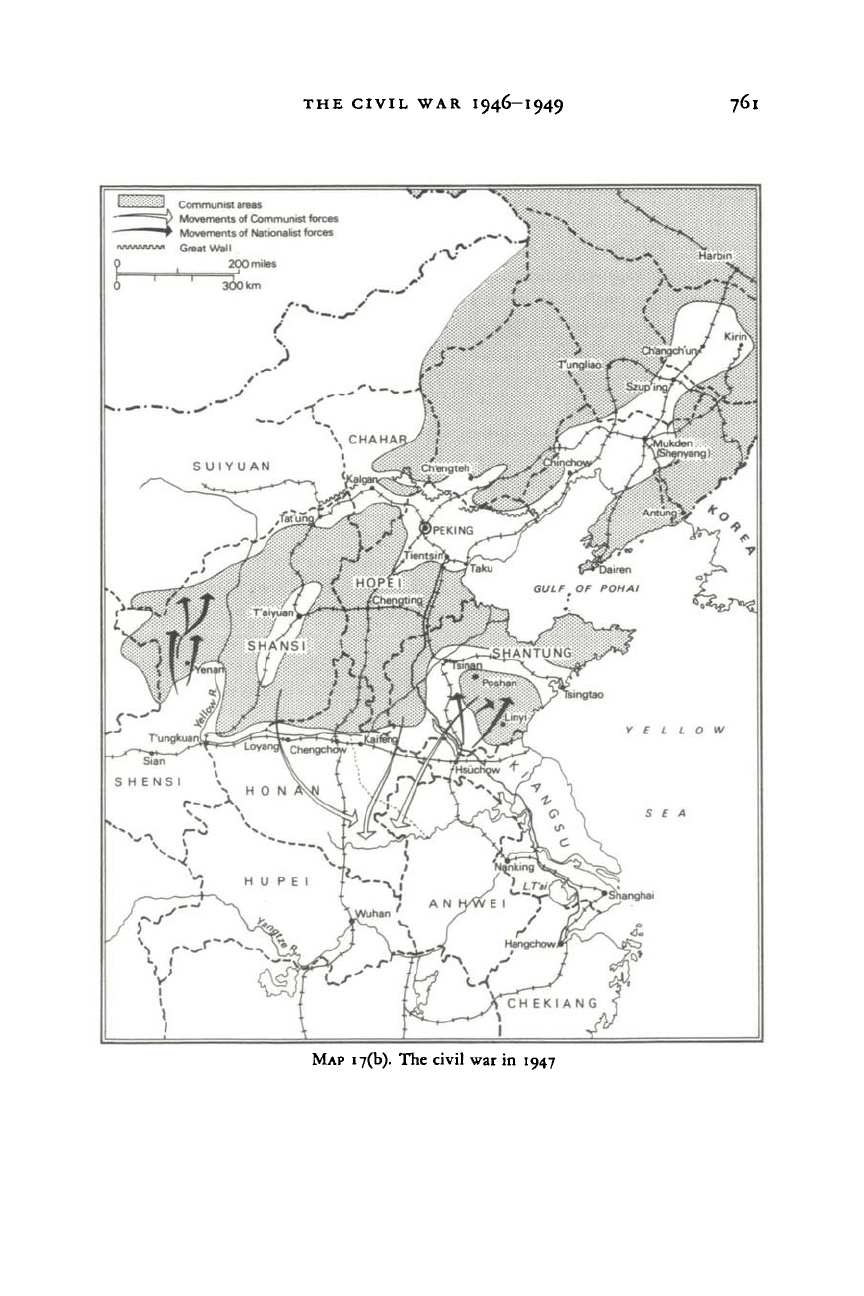
THE CIVIL
WAR
I946-I949
mill
—^
rwuuuuuvi
9
6
Communist areas
Movements of Communist forces
Movements of Nationalist forces
Great Wall
|
200 miles
'
300km
^•-
, -~
e
.-<
L
\7
-*
T'ung
^*~*~*
\
CHAHAJ/
SUIYUAN
'
J£
j /// / ,
ft"
/
SHA-NSI
^ ;
S
J
L
^ J
kuantC*^^^^^^^^^*^
SHENSI
V
u
~
..\.,
\ I
y
_,
\
i
L (
) 1
Y
1
1
I
/
*0
H U
P
E
1
-->
"v. • s.
i.\S
if U-^
Vvr
{
\
V
OPEI
A-henoting
i
^
k
1
han '
""
+/
IS
Us
r^
\
/
/
/
'
~"\\
V
IS
1
^I'engt
f
|)PEKI
r
1
•71
J
A
N
1
(
J)
1
1
<^
J^VE
1
<-"<
^_
VCH
1
V
.
%
N
\
>
^^
Tungliao
Jf^^
1
Jj^S
f
U-**Dairen
GULF
t
OF POHA
\
5 Tsingtao
-
-i i/5r^"j*short
'
r~
\
/ ;
•Changcri'un/
Lip ITtQf
^^^iS^
T^&nol
4 uonenyang)
*\
Antung^
1
<
E
L L 0
SEA
ndl
I
~jp
I
<
r\
*-S
<f>
EKIANG
f
rbi*n
A.
KinnS
"T
jr
MAP
i7(b).
The
civil
war in 1947
Cambridge Histories Online © Cambridge University Press, 2008
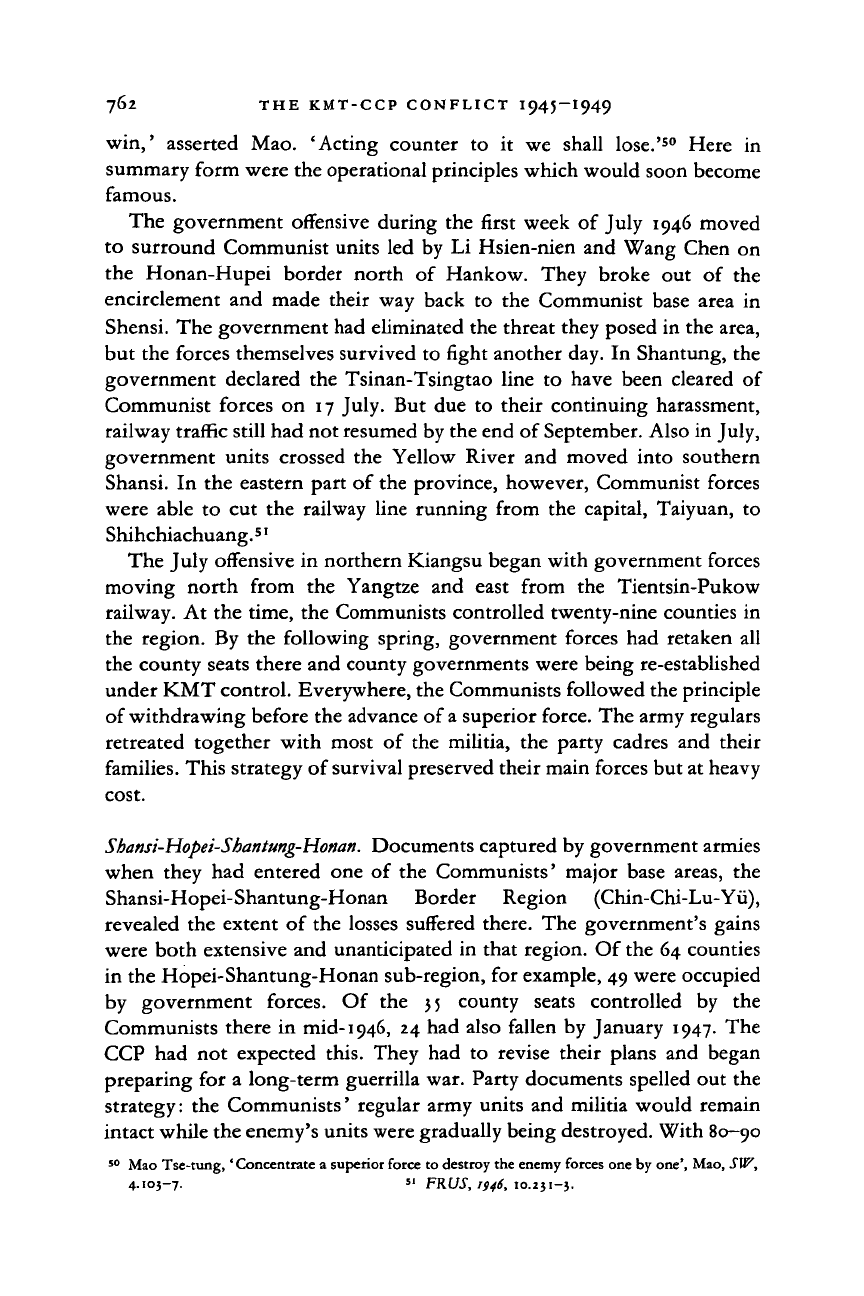
762 THE KMT-CCP CONFLICT I945-I949
win,' asserted Mao. 'Acting counter
to it we
shall lose.'
50
Here
in
summary form were the operational principles which would soon become
famous.
The government offensive during the first week of July 1946 moved
to surround Communist units led by Li Hsien-nien and Wang Chen on
the Honan-Hupei border north
of
Hankow. They broke
out of
the
encirclement and made their way back
to
the Communist base area
in
Shensi. The government had eliminated the threat they posed in the area,
but the forces themselves survived to fight another day. In Shantung, the
government declared the Tsinan-Tsingtao line
to
have been cleared of
Communist forces on 17 July. But due to their continuing harassment,
railway traffic still had not resumed by the end of September. Also in July,
government units crossed the Yellow River and moved into southern
Shansi. In the eastern part of the province, however, Communist forces
were able to cut the railway line running from the capital, Taiyuan,
to
Shihchiachuang.
5
'
The July offensive in northern Kiangsu began with government forces
moving north from
the
Yangtze and east from
the
Tientsin-Pukow
railway. At the time, the Communists controlled twenty-nine counties in
the region. By the following spring, government forces had retaken all
the county seats there and county governments were being re-established
under KMT control. Everywhere, the Communists followed the principle
of withdrawing before the advance of
a
superior force. The army regulars
retreated together with most
of
the militia, the party cadres and their
families. This strategy of survival preserved their main forces but at heavy
cost.
Shansi-Hopei-Sbantung-Honan.
Documents captured by government armies
when they had entered one
of
the Communists' major base areas, the
Shansi-Hopei-Shantung-Honan Border Region (Chin-Chi-Lu-Yii),
revealed the extent of the losses suffered there. The government's gains
were both extensive and unanticipated in that region. Of the 64 counties
in the Hopei-Shantung-Honan sub-region, for example, 49 were occupied
by government forces.
Of
the
35
county seats controlled
by the
Communists there in mid-1946, 24 had also fallen by January 1947. The
CCP had not expected this. They had
to
revise their plans and began
preparing for a long-term guerrilla war. Party documents spelled out the
strategy: the Communists' regular army units and militia would remain
intact while the enemy's units were gradually being destroyed. With 80—90
50
Mao Tse-tung,' Concentrate a superior force to destroy the enemy forces one by one', Mao, SW,
4.103-7.
5I
FRUS,
1946,
10.231-3.
Cambridge Histories Online © Cambridge University Press, 2008
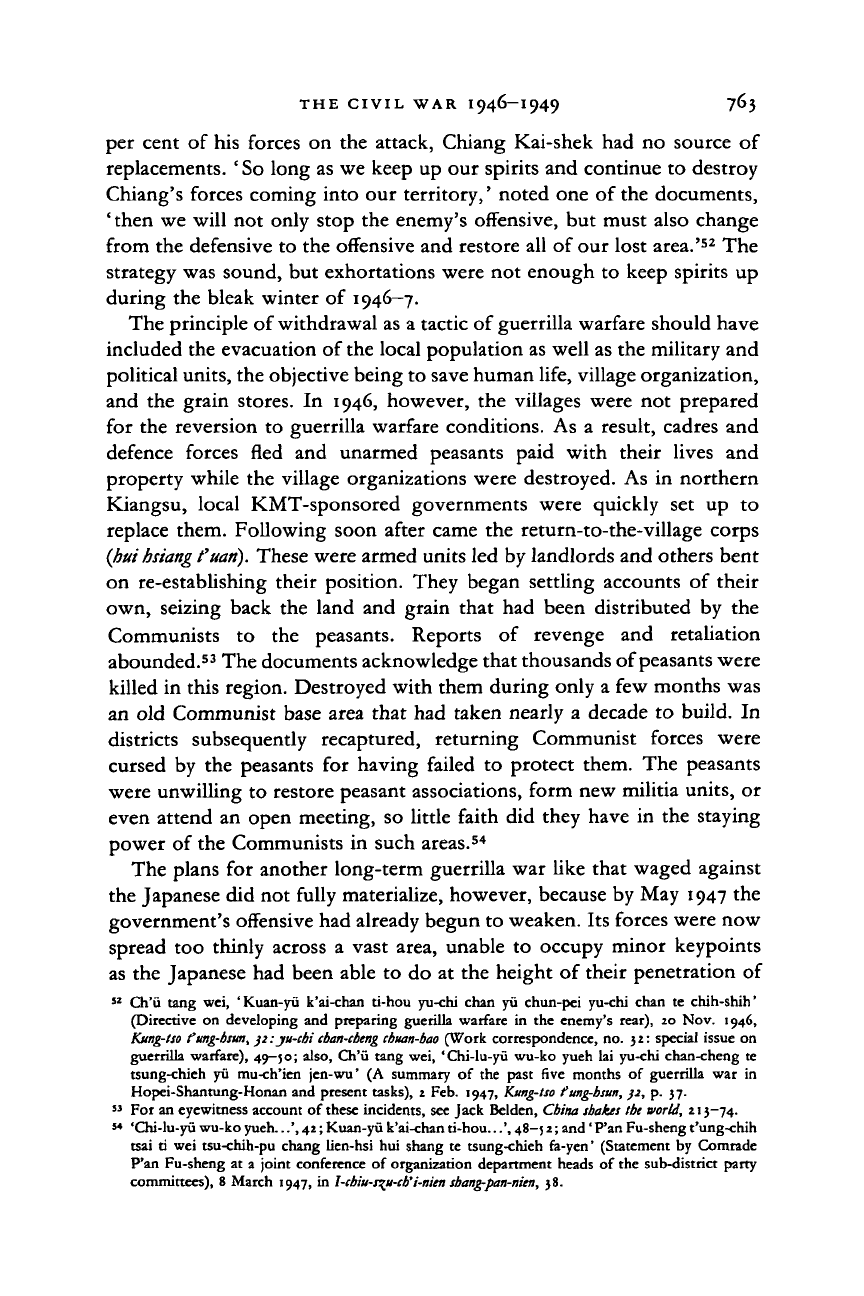
THE CIVIL WAR I946-I949 763
per cent of his forces on the attack, Chiang Kai-shek had no source of
replacements. ' So long as we keep up our spirits and continue to destroy
Chiang's forces coming into our territory,' noted one of the documents,
'then we will not only stop the enemy's offensive, but must also change
from the defensive to the offensive and restore all of our lost area.'
52
The
strategy was sound, but exhortations were not enough to keep spirits up
during the bleak winter of 1946—7.
The principle of withdrawal as a tactic of guerrilla warfare should have
included the evacuation of the local population as well as the military and
political units, the objective being to save human life, village organization,
and the grain stores. In 1946, however, the villages were not prepared
for the reversion to guerrilla warfare conditions. As a result, cadres and
defence forces fled and unarmed peasants paid with their lives and
property while the village organizations were destroyed. As in northern
Kiangsu, local KMT-sponsored governments were quickly set up to
replace them. Following soon after came the return-to-the-village corps
{hut hsiang
fuari).
These were armed units led by landlords and others bent
on re-establishing their position. They began settling accounts of their
own, seizing back the land and grain that had been distributed by the
Communists to the peasants. Reports of revenge and retaliation
abounded.
53
The documents acknowledge that thousands of peasants were
killed in this region. Destroyed with them during only a few months was
an old Communist base area that had taken nearly a decade to build. In
districts subsequently recaptured, returning Communist forces were
cursed by the peasants for having failed to protect them. The peasants
were unwilling to restore peasant associations, form new militia units, or
even attend an open meeting, so little faith did they have in the staying
power of the Communists in such areas.
54
The plans for another long-term guerrilla war like that waged against
the Japanese did not fully materialize, however, because by May 1947 the
government's offensive had already begun to weaken. Its forces were now
spread too thinly across a vast area, unable to occupy minor keypoints
as the Japanese had been able to do at the height of their penetration of
52
Ch'u tang wei, 'Kuan-yu k'ai-chan ti-hou yu-chi chan yu chun-pei yu-chi chan te chih-shih'
(Directive on developing and preparing guerilla warfare in the enemy's rear), 20 Nov. 1946,
Kurtg-lso t'ung-hsun, ji-.ju-cbi
cban-cbtng
tbuan-bao (Work correspondence, no. 32: special issue on
guerrilla warfare), 49—50; also, Ch'u tang wei, 'Chi-lu-yu wu-ko yueh lai yu-chi chan-cheng te
tsung-chieh yu mu-ch'ien jen-wu' (A summary of the past five months of guerrilla war in
Hopei-Shantung-Honan and present tasks), 2 Feb. 1947,
Kung-tso
fung-bsun,
)2, p. 37.
» For an eyewitness account of these incidents, see Jack Belden,
China shakes the
world,
213-74.
54
'Chi-lu-yu wu-ko yueh...', 42; Kuan-yu k'ai-chan ti-hou...', 48-5
2;
and' P'an Fu-sheng t'ung-chih
tsai ti wei tsu-chih-pu chang lien-hsi hui shang te tsung-chieh fa-yen' (Statement by Comrade
P'an Fu-sheng at a joint conference of organization department heads of the sub-district party
committees), 8 March 1947, in l-cbiu-s^u-cb'i-nien sbang-pan-nien, 38.
Cambridge Histories Online © Cambridge University Press, 2008
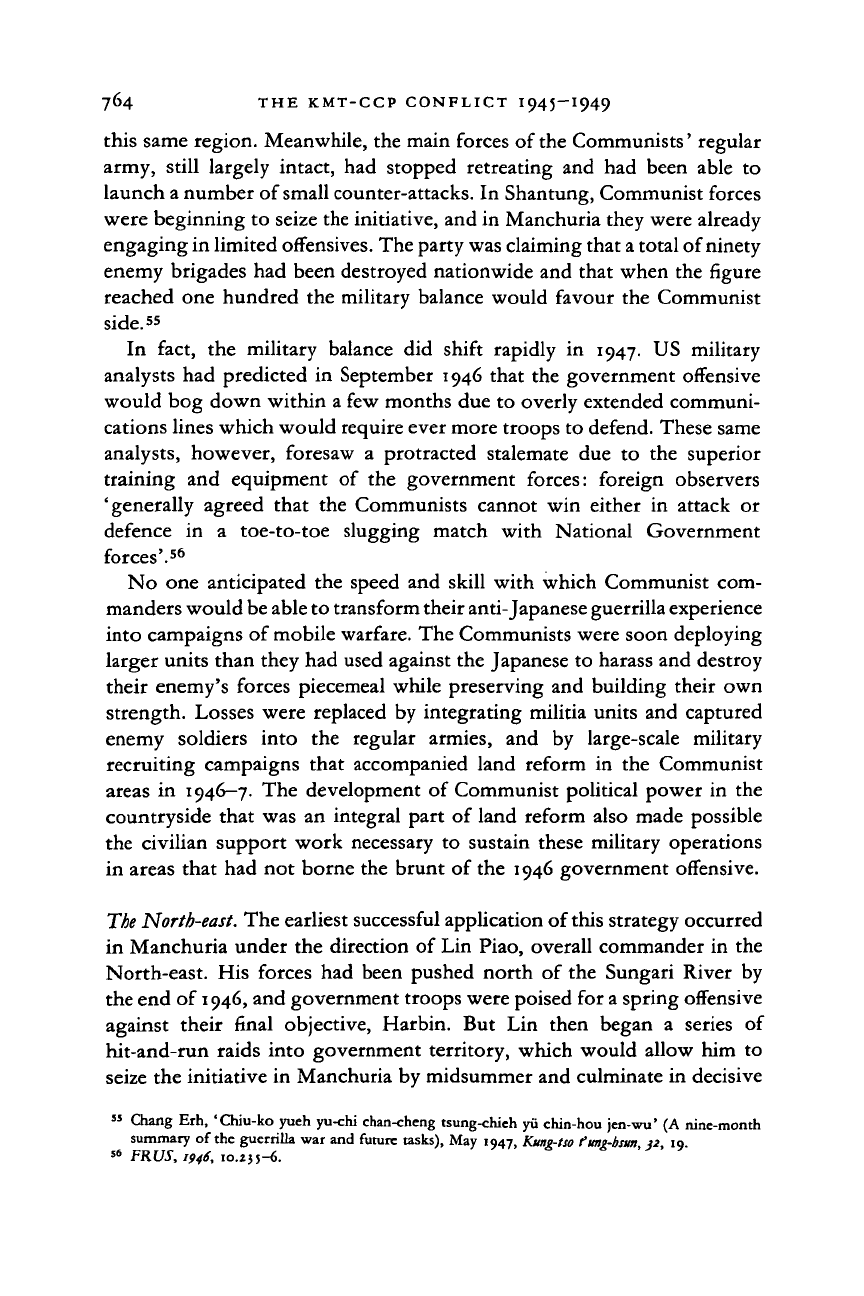
764 THE KMT-CCP CONFLICT I945-I949
this same region. Meanwhile, the main forces of the Communists' regular
army, still largely intact, had stopped retreating and had been able
to
launch a number of small counter-attacks. In Shantung, Communist forces
were beginning to seize the initiative, and in Manchuria they were already
engaging in limited offensives. The party was claiming that a total of ninety
enemy brigades had been destroyed nationwide and that when the figure
reached one hundred the military balance would favour the Communist
side.
55
In fact, the military balance did shift rapidly
in
1947. US military
analysts had predicted in September 1946 that the government offensive
would bog down within a few months due to overly extended communi-
cations lines which would require ever more troops to defend. These same
analysts, however, foresaw
a
protracted stalemate due
to
the superior
training and equipment
of
the government forces: foreign observers
'generally agreed that the Communists cannot win either
in
attack
or
defence
in a
toe-to-toe slugging match with National Government
forces'.
56
No one anticipated the speed and skill with which Communist com-
manders would be able to transform their anti-Japanese guerrilla experience
into campaigns of mobile warfare. The Communists were soon deploying
larger units than they had used against the Japanese to harass and destroy
their enemy's forces piecemeal while preserving and building their own
strength. Losses were replaced by integrating militia units and captured
enemy soldiers into
the
regular armies,
and by
large-scale military
recruiting campaigns that accompanied land reform
in
the Communist
areas in 1946—7. The development of Communist political power in the
countryside that was an integral part of land reform also made possible
the civilian support work necessary to sustain these military operations
in areas that had not borne the brunt of the 1946 government offensive.
The
North-east.
The earliest successful application of this strategy occurred
in Manchuria under the direction of Lin Piao, overall commander in the
North-east. His forces had been pushed north of the Sungari River by
the end of
1946,
and government troops were poised for a spring offensive
against their final objective, Harbin. But Lin then began
a
series
of
hit-and-run raids into government territory, which would allow him
to
seize the initiative in Manchuria by midsummer and culminate in decisive
" Chang Erh, 'Chiu-ko yueh yu-chi chan-cheng tsung-chieh yii chin-hou jen-wu' (A nine-month
summary of the guerrilla war and future tasks), May 1947,
Kuns-tso
funi-hsun 12
10
'« FRUS,
1946,
IO.ZJ5-6.
Cambridge Histories Online © Cambridge University Press, 2008
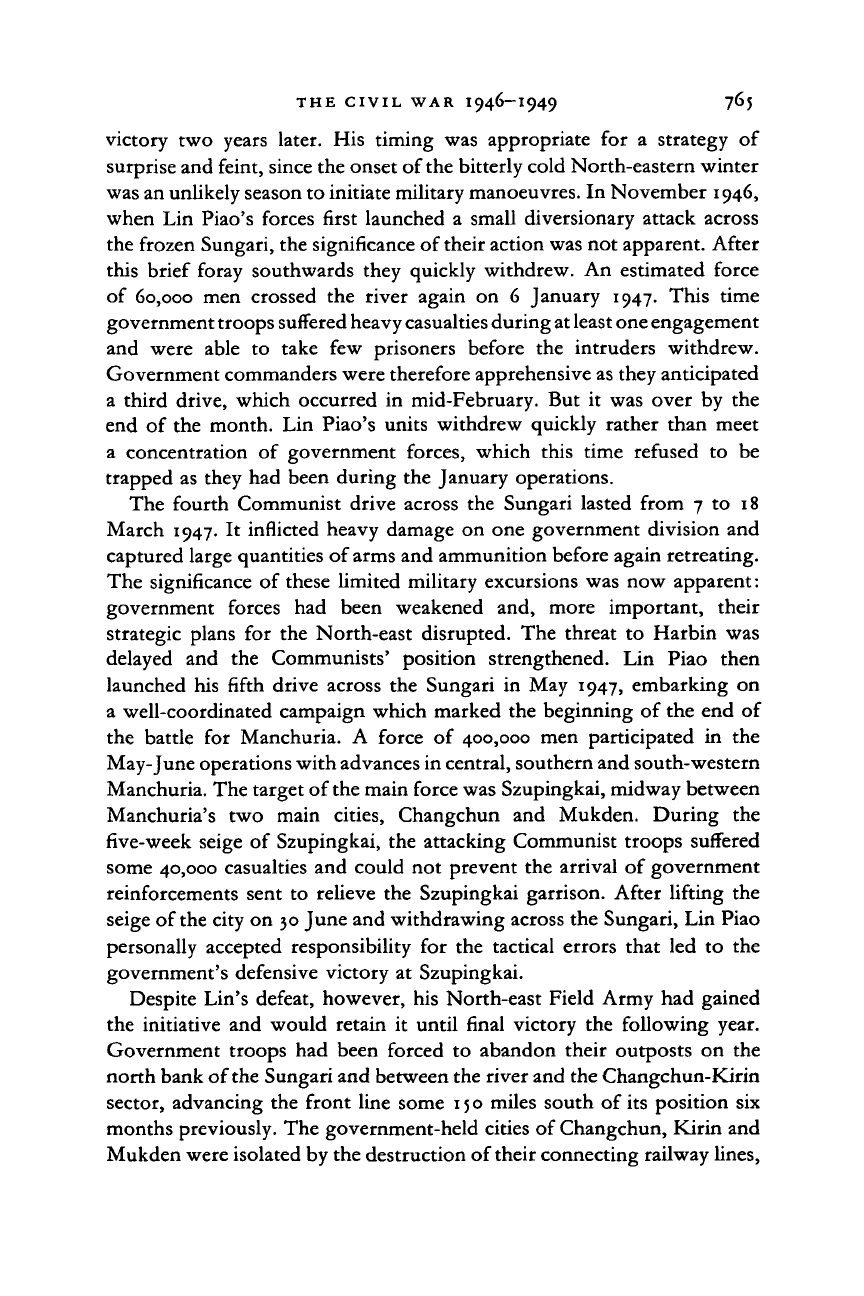
THE CIVIL WAR I946-I949 765
victory two years later. His timing was appropriate for a strategy of
surprise and feint, since the onset of
the
bitterly cold North-eastern winter
was an unlikely season to initiate military manoeuvres. In November 1946,
when Lin Piao's forces first launched a small diversionary attack across
the frozen Sungari, the significance of their action was not apparent. After
this brief foray southwards they quickly withdrew. An estimated force
of 60,000 men crossed the river again on 6 January 1947. This time
government troops suffered heavy casualties during at least one engagement
and were able to take few prisoners before the intruders withdrew.
Government commanders were therefore apprehensive as they anticipated
a third drive, which occurred in mid-February. But it was over by the
end of the month. Lin Piao's units withdrew quickly rather than meet
a concentration of government forces, which this time refused to be
trapped as they had been during the January operations.
The fourth Communist drive across the Sungari lasted from 7 to 18
March 1947. It inflicted heavy damage on one government division and
captured large quantities of
arms
and ammunition before again retreating.
The significance of these limited military excursions was now apparent:
government forces had been weakened and, more important, their
strategic plans for the North-east disrupted. The threat to Harbin was
delayed and the Communists' position strengthened. Lin Piao then
launched his fifth drive across the Sungari in May 1947, embarking on
a well-coordinated campaign which marked the beginning of the end of
the battle for Manchuria. A force of 400,000 men participated in the
May-June operations with advances in central, southern and south-western
Manchuria. The target of the main force was Szupingkai, midway between
Manchuria's two main cities, Changchun and Mukden. During the
five-week seige of Szupingkai, the attacking Communist troops suffered
some 40,000 casualties and could not prevent the arrival of government
reinforcements sent to relieve the Szupingkai garrison. After lifting the
seige of the city on 30 June and withdrawing across the Sungari, Lin Piao
personally accepted responsibility for the tactical errors that led to the
government's defensive victory at Szupingkai.
Despite Lin's defeat, however, his North-east Field Army had gained
the initiative and would retain it until final victory the following year.
Government troops had been forced to abandon their outposts on the
north bank of the Sungari and between the river and the Changchun-Kirin
sector, advancing the front line some
15 o
miles south of its position six
months previously. The government-held cities of Changchun, Kirin and
Mukden were isolated by the destruction of their connecting railway lines,
Cambridge Histories Online © Cambridge University Press, 2008
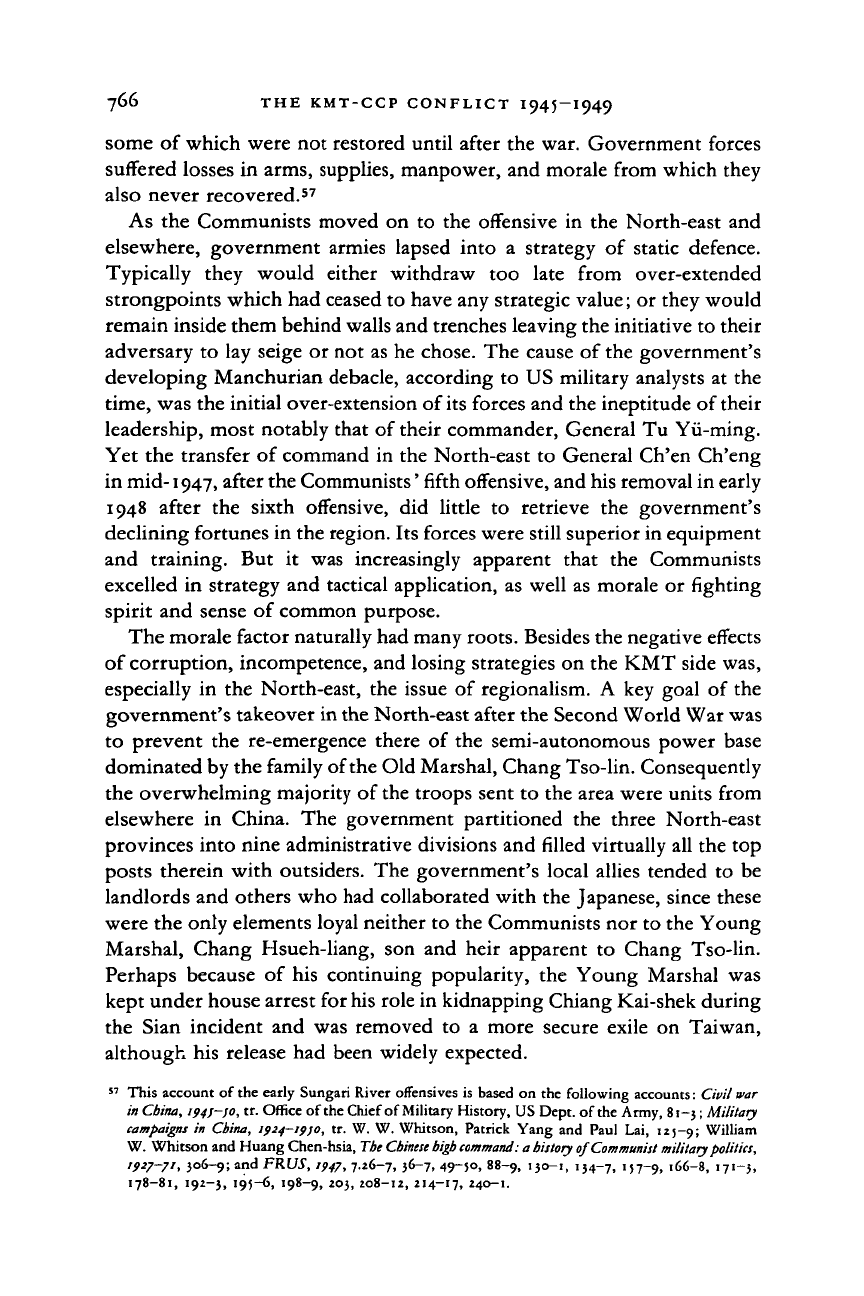
766 THE KMT-CCP CONFLICT I945-I949
some of which were not restored until after the war. Government forces
suffered losses in arms, supplies, manpower, and morale from which they
also never recovered.
57
As the Communists moved on
to
the offensive
in
the North-east and
elsewhere, government armies lapsed into
a
strategy
of
static defence.
Typically they would either withdraw
too
late from over-extended
strongpoints which had ceased to have any strategic value; or they would
remain inside them behind walls and trenches leaving the initiative to their
adversary to lay seige or not as he chose. The cause of the government's
developing Manchurian debacle, according to US military analysts at the
time,
was the initial over-extension of
its
forces and the ineptitude of their
leadership, most notably that of their commander, General Tu Yii-ming.
Yet the transfer of command in the North-east to General Ch'en Ch'eng
in mid-1947, after the Communists' fifth offensive, and his removal in early
1948 after
the
sixth offensive,
did
little
to
retrieve
the
government's
declining fortunes in the region. Its forces were still superior in equipment
and training.
But it
was increasingly apparent that
the
Communists
excelled
in
strategy and tactical application, as well as morale or fighting
spirit and sense of common purpose.
The morale factor naturally had many roots. Besides the negative effects
of corruption, incompetence, and losing strategies on the KMT side was,
especially
in
the North-east, the issue
of
regionalism.
A
key goal
of
the
government's takeover in the North-east after the Second World War was
to prevent the re-emergence there
of
the semi-autonomous power base
dominated by the family of the Old Marshal, Chang Tso-lin. Consequently
the overwhelming majority of the troops sent to the area were units from
elsewhere
in
China. The government partitioned
the
three North-east
provinces into nine administrative divisions and filled virtually all the top
posts therein with outsiders. The government's local allies tended
to be
landlords and others who had collaborated with the Japanese, since these
were the only elements loyal neither to the Communists nor to the Young
Marshal, Chang Hsueh-liang, son and heir apparent
to
Chang Tso-lin.
Perhaps because
of
his continuing popularity, the Young Marshal was
kept under house arrest for his role in kidnapping Chiang Kai-shek during
the Sian incident and was removed
to a
more secure exile
on
Taiwan,
although his release had been widely expected.
57
This account
of
the early Sungari River offensives
is
based
on
the following accounts: Civil war
in China,
194J—10,
tr. Office of the Chief of Military History, US Dept. of the Army, 81-3; Military
campaigns
in
China, 1)24-19)0,
tr.
W. W. Whitson, Patrick Yang and Paul Lai, 12J-9; William
W. Whitson and Huang Chen-hsia, The
Chinese high
command:
a history of Communist military politics,
1927-71,
306-9; and FRUS, 1947, 7.26-7, 36-7, 49-50, 88-9,
130-1,
134-7, 157-9, ><><>-8. 171-3,
178—81,
192—3, 195-6, '98-9, 203, 208-12, 214-17,
240-1.
Cambridge Histories Online © Cambridge University Press, 2008

THE CIVIL WAR I946-I949 767
After the Japanese surrender, initial support for the KMT in the
North-east appeared genuine according to contemporary accounts. But the
' southerners' soon wore out their welcome. Resentment created by their
discriminatory takeover policies and the venality of their officials quickly
produced a resurgence of regionalism. Regional loyalties might not have
weighed so heavily had the government's record in the North-east been
less open to criticism. People in the North-east, as in Taiwan, a region
with an even longer history of Japanese rule, were often heard to comment
that Japan had given them better government than the KMT. In
particular, the government's effort against the Communists in the region
could hardly have succeeded without the participation of local leaders.
Yet so great was the KMT suspicion of them and the power they
represented that it spurned even such aid as they were willing to offer.
Li Tsung-jen in his
Memoirs
traces this error to Chiang Kai-shek
himself,
who remained 'prejudiced against native Manchurians'. Thus a locally
formed North-east Mobilization Commission volunteered to organize a
defence force to fight the Communists. But the offer was refused, although
government commanders were never able to organize an effective local
guerrilla force themselves. General Ma Chan-shen, a cavalry officer who
had served under both the Old and Young Marshals, agreed to work with
the government and was made a deputy commander of the North-east
Command, but he
was.
never given anything to do nor any troops to lead.
Meanwhile, government commanders in the North-east were obliged to
rely on 'outsiders' as their major source of troop replacements. Due to
the failure of their recruiting drives in the North-east, government forces
had to bring replacements for their lost and damaged divisions from areas
inside China which could ill afford to lose them.
58
The Communists took full advantage of the popular resentment these
measures aroused. They avoided the central government's arrogant
attitude toward the people of the North-east and used local talent
wherever possible. Most of the surviving units from the old North-east
army of Chang Tso-lin and Chang Hsueh-liang went over to the
Communists, as did one of the latter's younger brothers, General Chang
Hsueh-szu. The Communists welcomed them as allies and allowed them
to retain their identity as a non-Communist force under the overall
command of Lin Piao. As the Communist administered areas expanded,
the North-east Field Army was able to replenish its regular units by
recruiting locally; it organized an effective second-line force of local
irregulars and mobilized more than a million civilian support workers to
serve under its logistics command.
58
Li Tsung-jen, 434; FRUS,
1947,
7.141-2, 144-5, 211-12, 232-5.
Cambridge Histories Online © Cambridge University Press, 2008
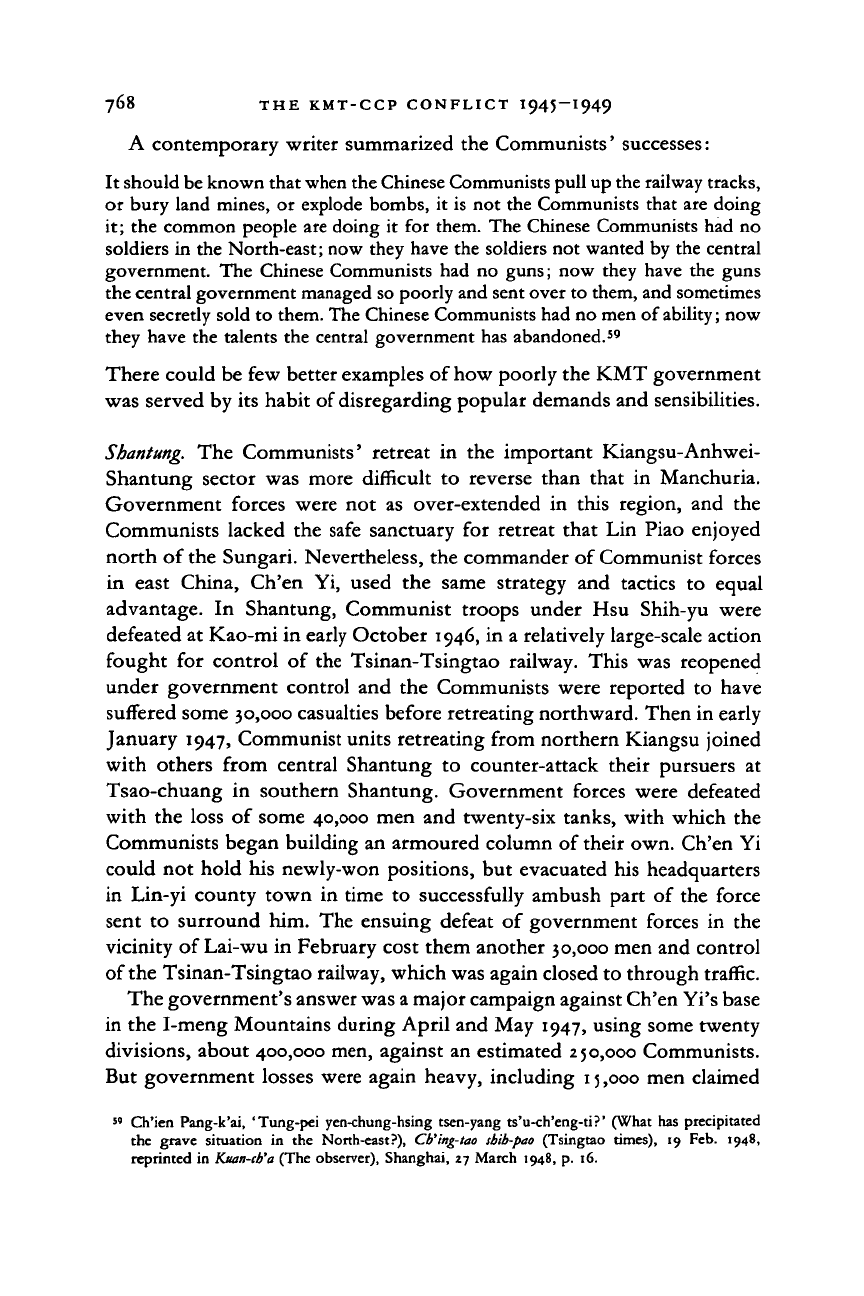
768 THE KMT-CCP CONFLICT I945-1949
A contemporary writer summarized the Communists' successes:
It should be known that
when
the Chinese Communists pull up the railway tracks,
or bury land mines, or explode bombs, it is not the Communists that are doing
it; the common people are doing it for them. The Chinese Communists had no
soldiers in the North-east; now they have the soldiers not wanted by the central
government. The Chinese Communists had no guns; now they have the guns
the central government managed so poorly and sent over to them, and sometimes
even secretly sold to them. The Chinese Communists had no men of
ability;
now
they have the talents the central government has abandoned.
59
There could be few better examples of how poorly the KMT government
was served by its habit of disregarding popular demands and sensibilities.
Shantung. The Communists' retreat
in
the important Kiangsu-Anhwei-
Shantung sector was more difficult
to
reverse than that
in
Manchuria.
Government forces were not
as
over-extended
in
this region, and the
Communists lacked the safe sanctuary for retreat that Lin Piao enjoyed
north of the Sungari. Nevertheless, the commander of Communist forces
in east China, Ch'en Yi, used the same strategy and tactics
to
equal
advantage.
In
Shantung, Communist troops under Hsu Shih-yu were
defeated at Kao-mi in early October 1946, in a relatively large-scale action
fought
for
control
of
the Tsinan-Tsingtao railway. This was reopened
under government control and the Communists were reported
to
have
suffered some 30,000 casualties before retreating northward. Then in early
January 1947, Communist units retreating from northern Kiangsu joined
with others from central Shantung
to
counter-attack their pursuers
at
Tsao-chuang
in
southern Shantung. Government forces were defeated
with the loss of some 40,000 men and twenty-six tanks, with which the
Communists began building an armoured column of their own. Ch'en Yi
could not hold his newly-won positions, but evacuated his headquarters
in Lin-yi county town in time
to
successfully ambush part of the force
sent
to
surround him. The ensuing defeat of government forces
in
the
vicinity of Lai-wu in February cost them another 30,000 men and control
of the Tsinan-Tsingtao railway, which was again closed to through traffic.
The government's answer was a major campaign against Ch'en Yi's base
in the I-meng Mountains during April and May 1947, using some twenty
divisions, about 400,000 men, against an estimated 250,000 Communists.
But government losses were again heavy, including 15,000 men claimed
" Ch'ien Pang-k'ai, 'Tung-pei yen-chung-hsing tsen-yang ts'u-ch'eng-ti?' (What has precipitated
the grave situation
in the
North-east?), Cb'ing-tao
sbib-pao
(Tsingtao times),
19
Feb. 1948,
reprinted in Ktun-cb'a (The obsetver), Shanghai, 27 March 1948, p. 16.
Cambridge Histories Online © Cambridge University Press, 2008
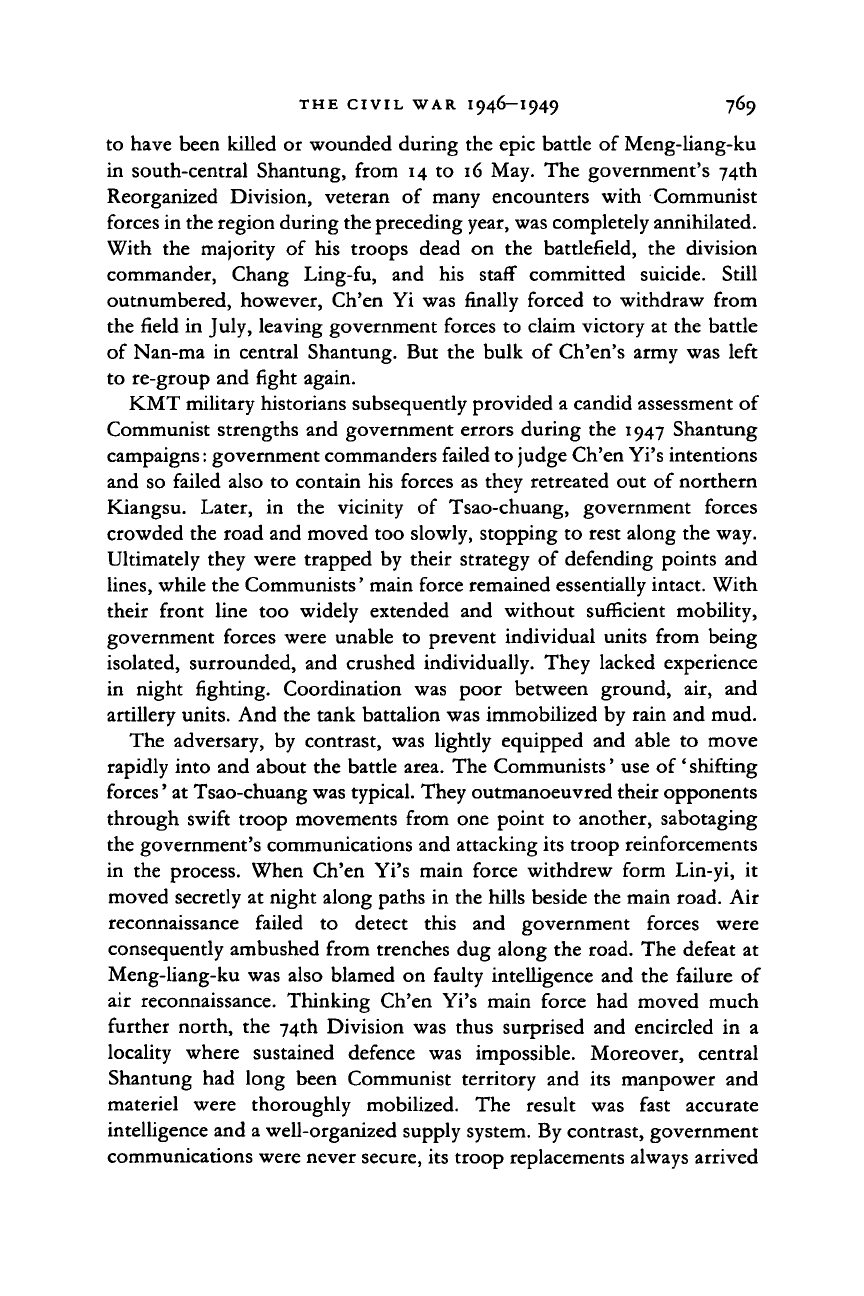
THE CIVIL WAR I946—1949 769
to have been killed or wounded during the epic battle of Meng-liang-ku
in south-central Shantung, from 14 to 16 May. The government's 74th
Reorganized Division, veteran of many encounters with Communist
forces in the region during the preceding year, was completely annihilated.
With the majority of his troops dead on the battlefield, the division
commander, Chang Ling-fu, and his staff committed suicide. Still
outnumbered, however, Ch'en Yi was finally forced to withdraw from
the field in July, leaving government forces to claim victory at the battle
of Nan-ma in central Shantung. But the bulk of Ch'en's army was left
to re-group and fight again.
KMT military historians subsequently provided a candid assessment of
Communist strengths and government errors during the 1947 Shantung
campaigns: government commanders failed to judge Ch'en Yi's intentions
and so failed also to contain his forces as they retreated out of northern
Kiangsu. Later, in the vicinity of Tsao-chuang, government forces
crowded the road and moved too slowly, stopping to rest along the way.
Ultimately they were trapped by their strategy of defending points and
lines,
while the Communists' main force remained essentially intact. With
their front line too widely extended and without sufficient mobility,
government forces were unable to prevent individual units from being
isolated, surrounded, and crushed individually. They lacked experience
in night fighting. Coordination was poor between ground, air, and
artillery units. And the tank battalion was immobilized by rain and mud.
The adversary, by contrast, was lightly equipped and able to move
rapidly into and about the battle area. The Communists' use of' shifting
forces' at Tsao-chuang was typical. They outmanoeuvred their opponents
through swift troop movements from one point to another, sabotaging
the government's communications and attacking its troop reinforcements
in the process. When Ch'en Yi's main force withdrew form Lin-yi, it
moved secretly at night along paths in the hills beside the main road. Air
reconnaissance failed to detect this and government forces were
consequently ambushed from trenches dug along the road. The defeat at
Meng-liang-ku was also blamed on faulty intelligence and the failure of
air reconnaissance. Thinking Ch'en Yi's main force had moved much
further north, the 74th Division was thus surprised and encircled in a
locality where sustained defence was impossible. Moreover, central
Shantung had long been Communist territory and its manpower and
materiel were thoroughly mobilized. The result was fast accurate
intelligence and a well-organized supply system. By contrast, government
communications were never secure, its troop replacements always arrived
Cambridge Histories Online © Cambridge University Press, 2008
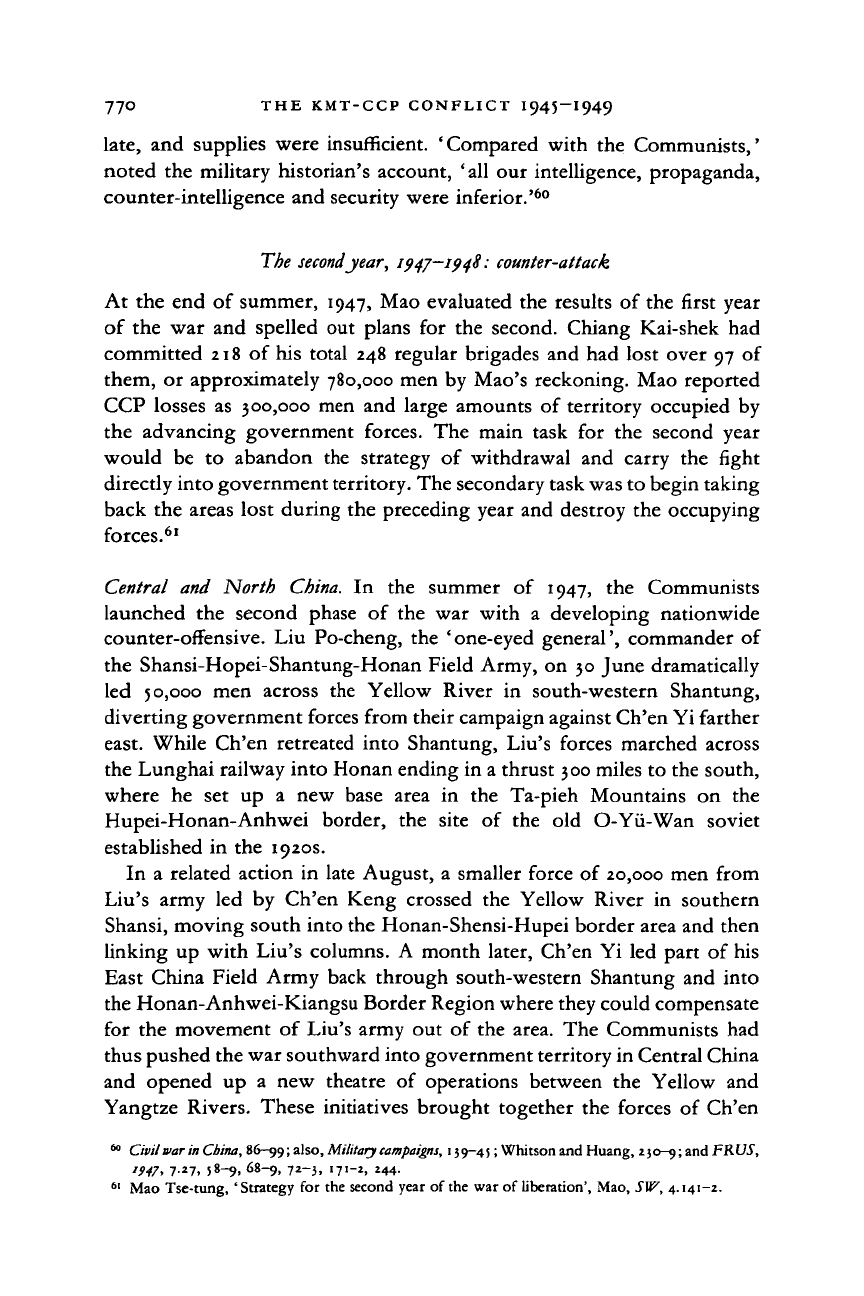
77° THE KMT-CCP CONFLICT I945-I949
late,
and supplies were insufficient. 'Compared with the Communists,'
noted the military historian's account, 'all our intelligence, propaganda,
counter-intelligence and security were inferior.'
60
The second year, 1947-1948: counter-attack
At the end of summer, 1947, Mao evaluated the results of the first year
of the war and spelled out plans for the second. Chiang Kai-shek had
committed 218 of his total 248 regular brigades and had lost over 97 of
them, or approximately 780,000 men by Mao's reckoning. Mao reported
CCP losses as 300,000 men and large amounts of territory occupied by
the advancing government forces. The main task
for
the second year
would
be to
abandon the strategy
of
withdrawal and carry the fight
directly into government territory. The secondary task was to begin taking
back the areas lost during the preceding year and destroy the occupying
forces.
61
Central and North China.
In the
summer
of
1947,
the
Communists
launched the second phase
of
the war with
a
developing nationwide
counter-offensive. Liu Po-cheng, the 'one-eyed general', commander of
the Shansi-Hopei-Shantung-Honan Field Army, on 30 June dramatically
led 50,000 men across the Yellow River
in
south-western Shantung,
diverting government forces from their campaign against Ch'en Yi farther
east. While Ch'en retreated into Shantung, Liu's forces marched across
the Lunghai railway into Honan ending in a thrust 300 miles to the south,
where
he set up a
new base area
in the
Ta-pieh Mountains
on the
Hupei-Honan-Anhwei border,
the
site
of
the
old
O-Yii-Wan soviet
established in the 1920s.
In
a
related action in late August, a smaller force of 20,000 men from
Liu's army led
by
Ch'en Keng crossed the Yellow River
in
southern
Shansi, moving south into the Honan-Shensi-Hupei border area and then
linking up with Liu's columns. A month later, Ch'en Yi led part of his
East China Field Army back through south-western Shantung and into
the Honan-Anhwei-Kiangsu Border Region where they could compensate
for the movement of Liu's army out of the area. The Communists had
thus pushed the war southward into government territory in Central China
and opened
up a
new theatre
of
operations between the Yellow and
Yangtze Rivers. These initiatives brought together the forces
of
Ch'en
60
Civil war in China, 86-99; also, Military campaigns, 139-45; Whitson and Huang, 230-9; and FRUS,
'947,
7-*7>
J8-9.
68
~9> 72-3. >7'~*. *44-
61
Mao Tse-tung, 'Strategy for the second year of the war of liberation', Mao, SW, 4.141-2.
Cambridge Histories Online © Cambridge University Press, 2008
